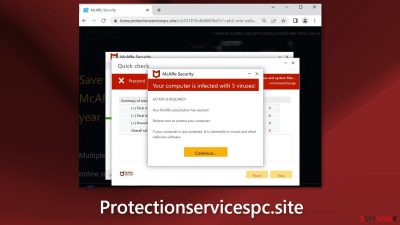Protectionservicespc.site ads (fake) - Free Guide
Protectionservicespc.site ads Removal Guide
What is Protectionservicespc.site ads?
Protectionservicespc.site is disguised as a security alert from McAfee to manipulate people

Protectionservicespc.site is a fake website that tries to trick users into thinking that their PC is infected with multiple viruses. The message is designed to look like a security alert from McAfee. The domain implies that the website acts as a quick pc scanner but it is just another social engineering trick.
If people interact with the page, they will be shown a fake animation of a system scan. Of course, when it finishes, non-existent threats are supposedly found on the machine. Users are then prompted to subscribe to McAfee services. The main goal of this scheme is to redirect people to the official McAfee website.
Crooks make money through the affiliate program for every subscription service. The site may also cause push notification spam. Fraudsters then would generate revenue through pay-per-click advertising. Unfortunately, they may use rogue advertising networks[1] that place ads leading to dangerous websites.
People may end up on scam sites that try to lure out personal information or trick them into downloading PUPs (potentially unwanted programs),[2] and even malware. People usually report seeing ads promoting adult sites, fake software deals, giveaways, surveys, etc. However, people also report that they see pop-ups that look like security alerts from McAfee.
| NAME | Protectionservicespc.site |
| TYPE | Push notification spam, adware |
| SYMPTOMS | Users may start seeing pop-ups that say their system is infected; the amount of commercial content on the machine might increase |
| DISTRIBUTION | Shady websites; deceptive ads; freeware installations |
| DANGERS | The website may cause unnecessary installations of antivirus programs or cause pop-ups leading to shady sites |
| ELIMINATION | Check your browser for malicious browser extensions, and scan your machine with anti-malware tools; follow our guide for push notification removal instructions |
| FURTHER STEPS | Use FortectIntego to clear your browsers and get rid of any remaining damage |
Distribution methods
Pages, like Protectionservicespc.site rarely appear in the search results. Usually, they are hidden on other shady websites that are unregulated. For example, illegal streaming websites are full of deceptive ads and sneaky redirects. Some of them may even display fake “Download” and “Play” buttons. That is why it is best to only visit websites that you know and trust. Do not click on random links and ads even if they seem to be promoting legitimate products or services.
There is also a possibility that the deceptive page appeared without any user input. This can happen if you are infected by adware.[3] It is advertising-supported software that can cause an increased amount of commercial content, like pop-ups, banners, and redirects.
Adware is mostly spread through freeware installation platforms. They include bundled software in the installers and do not disclose it clearly on their sites. To avoid this, always pay close attention during the installation process. Choose the “Custom” or “Advanced” installation methods, read the Privacy Policy and Terms of Use. The most important step is to check the file list and untick the boxes next to any unrelated applications.

Disable push notifications
If you want to disable those annoying virus alerts from Protectionservicespc.site, you have to turn off the site permissions that allow it to show you push notifications. You can do that by following our step-by-step guide:
Google Chrome (desktop):
- Open Google Chrome browser and go to Menu > Settings.
- Scroll down and click on Advanced.
- Locate the Privacy and security section and pick Site Settings > Notifications.
![Stop notifications on Chrome PC 1 Stop notifications on Chrome PC 1]()
- Look at the Allow section and look for a suspicious URL.
- Click the three vertical dots next to it and pick Block. This should remove unwanted notifications from Google Chrome.
![Stop notifications on Chrome PC 2 Stop notifications on Chrome PC 2]()
Mozilla Firefox:
- Open Mozilla Firefox and go to Menu > Options.
- Click on Privacy & Security section.
- Under Permissions, you should be able to see Notifications. Click Settings button next to it.
![Stop notifications on Mozilla Firefox 1 Stop notifications on Mozilla Firefox 1]()
- In the Settings – Notification Permissions window, click on the drop-down menu by the URL in question.
- Select Block and then click on Save Changes. This should remove unwanted notifications from Mozilla Firefox.
![Stop notifications on Mozilla Firefox 2 Stop notifications on Mozilla Firefox 2]()
MS Edge:
- Open Microsoft Edge, and click the Settings and more button (three horizontal dots) at the top-right of the window.
- Select Settings and then go to Advanced.
- Under Website permissions, pick Manage permissions and select the URL in question.
- Toggle the switch to the left to turn notifications off on Microsoft Edge.
![Stop notifications on Edge 2 Stop notifications on Edge 2]()
Check the browser for malicious extensions
Check if your browser is affected by a browser hijacker. Some symptoms may include changed settings (homepage, new tab address, and search engine), increased commercial content, and unknown extensions added to the settings.
Web-based applications can automatically redirect users to scam sites, such as Protectionservicespc.site. You should go to your browser settings and see if any plugins are added. We recommend removing the add-ons one by one to see if you notice any changes.
Clear your browsers
After successful removal, we recommend using FortectIntego repair tool to care for your browsers. Almost every website you visit uses cookies to track your browsing activity, like the pages you visit, links you click on, and purchases you make.
If you have pop-ups appearing from questionable sources, it most likely means that you were surfing through web pages you should not and clicked on dangerous links. Your browsing data might be exposed or sold to advertising networks and other third parties that use it for malicious purposes.
Use anti-malware tools to scan your machine
Suppose you disabled push notifications and checked the browser for extensions but still experience unwanted symptoms like unexpected redirects and an increased amount of commercial content. In that case, you should scan your system for adware. We suggest using trusted professional security tools SpyHunter 5Combo Cleaner or Malwarebytes for PUP removal.
It should detect most suspicious apps and remove them successfully. Of course, you can also remove a PUP manually, but it is unknown which particular app could be causing annoying behavior, as crooks disguise them as “handy” tools. Manual uninstallation can also leave some traces of the program behind, which could result in the renewal of the infection.
However, if you still do not want to use security tools and know which program is at fault, use the instructions below to help you uninstall it:
Windows 10/8:
- Enter Control Panel into Windows search box and hit Enter or click on the search result.
- Under Programs, select Uninstall a program.
![Uninstall from Windows 1 Uninstall from Windows 1]()
- From the list, find the entry of the suspicious program.
- Right-click on the application and select Uninstall.
- If User Account Control shows up, click Yes.
- Wait till uninstallation process is complete and click OK.
![Uninstall from Windows 2 Uninstall from Windows 2]()
Windows 7/XP:
- Click on Windows Start > Control Panel located on the right pane (if you are Windows XP user, click on Add/Remove Programs).
- In Control Panel, select Programs > Uninstall a program.
![Uninstall from Windows 7/XP Uninstall from Windows 7/XP]()
- Pick the unwanted application by clicking on it once.
- At the top, click Uninstall/Change.
- In the confirmation prompt, pick Yes.
- Click OK once the removal process is finished.
Mac:
- From the menu bar, select Go > Applications.
- In the Applications folder, look for all related entries.
- Click on the app and drag it to Trash (or right-click and pick Move to Trash)
![Uninstall from Mac 1 Uninstall from Mac 1]()
To fully remove an unwanted app, you need to access Application Support, LaunchAgents, and LaunchDaemons folders and delete relevant files:
- Select Go > Go to Folder.
- Enter /Library/Application Support and click Go or press Enter.
- In the Application Support folder, look for any dubious entries and then delete them.
- Now enter /Library/LaunchAgents and /Library/LaunchDaemons folders the same way and terminate all the related .plist files.
![Uninstall from Mac 2 Uninstall from Mac 2]()
How to prevent from getting adware
Stream videos without limitations, no matter where you are
There are multiple parties that could find out almost anything about you by checking your online activity. While this is highly unlikely, advertisers and tech companies are constantly tracking you online. The first step to privacy should be a secure browser that focuses on tracker reduction to a minimum.
Even if you employ a secure browser, you will not be able to access websites that are restricted due to local government laws or other reasons. In other words, you may not be able to stream Disney+ or US-based Netflix in some countries. To bypass these restrictions, you can employ a powerful Private Internet Access VPN, which provides dedicated servers for torrenting and streaming, not slowing you down in the process.
Data backups are important – recover your lost files
Ransomware is one of the biggest threats to personal data. Once it is executed on a machine, it launches a sophisticated encryption algorithm that locks all your files, although it does not destroy them. The most common misconception is that anti-malware software can return files to their previous states. This is not true, however, and data remains locked after the malicious payload is deleted.
While regular data backups are the only secure method to recover your files after a ransomware attack, tools such as Data Recovery Pro can also be effective and restore at least some of your lost data.
- ^ Zeljka Zorz. How does a rogue ad network function?. Helpnetsecurity. Information Security.
- ^ Wendy Zamora. What is a PUP? – How to avoid potentially unwanted programs. Malwarebytes. Security Tips, Tricks and How-Tos.
- ^ Adware. Wikipedia, the free encyclopedia.










